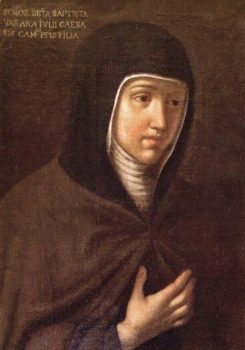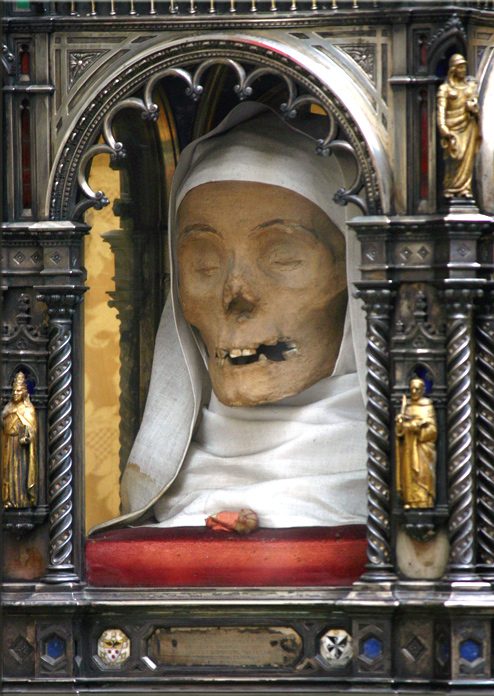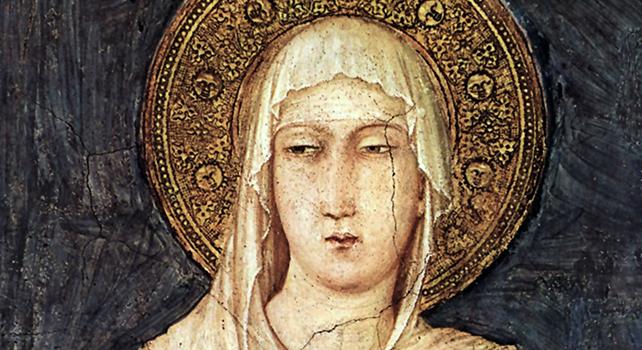{:en}Between the Middle Ages and the Renaissance, in a middle Italy such as the one that goes from Tuscany to the Marche passing through Umbria - will it be the landscape that acts as a stimulus? – there are three mystics who, through a process of canonization by the Church, were proclaimed saints: Catherine of Siena, Clare of Assisi and Battista da Camerino.
Women who emerged from the silence to which they were destined: future wives of nobles or bourgeois at courts or workshops, they decided to listen to themselves until the end, in coherence with their feelings, they spent their lives in constant dialogue with Christ, controlled by seen by the ecclesiastical authority who kept their actions in constant doubt. Caterina, daughter of the lower middle class of the Sienese district of Oca, began as a teenager, like Battista and Chiara, the latter coming from noble and rich families, to have visions, to leave the world to sink into the spiritual interior, continuously abstaining from food and sleep. Battista writes the “ mental pains of Jesus" , Catherine "in the precious blood of Christ", or in cinnabar ink, exposes her dialogues " hiding in the wounds of crucified Christ, I bathed in his blood” through the help of several biographers, one of whom, Tommaso Caffarini, asserts that he could write on her behalf because he saw her take pen and paper or quill and parchment and write quickly. Clare of Assisi will dictate the rules for her sisters, and she is the first woman to do so, among which the most important is that of not owning any property, she who has been accustomed since childhood to seeing her family struggling for power and money, realizes that renouncing both is a guarantee of enjoyment and mastery of one's inner conscience.
 In the photo: Battista da Varano from Camerino
In the photo: Battista da Varano from Camerino
Battista da Varano, of the powerful house of the lords of Camerino, challenges his father Julius Caesar and follows the sermons of the blessed Pietro da Mogliano, leading himself to religious life, which he initially hated.
Battista is a scholar, accustomed to court life where the arts and letters are cultivated, she knows Latin and knows how to ride a horse, but at a certain point she decides to consecrate her life to Christ and write for his glory.
Writing, for all, becomes the means to affirm themselves and escape from the predestined role – to offer that love to Jesus free from sin,” that thing that isn't there” , Caterina will affirm, “ it's just a lack of love, and that is the only real sin that is committed" , writing is the only way”with which to vent your heart, so that it doesn't explode" (Catherine of Siena).
 In the photo: head of Saint Catherine of Siena. Basilica of San Domenico, Siena
In the photo: head of Saint Catherine of Siena. Basilica of San Domenico, Siena
Women who are subversive in their own way, outside the box, strong women who talk to popes and rulers, Caterina becomes spokesperson for a church in Rome alternating with that of Avignon, which she considers the Antichrist, Chiara in her vision of absolute poverty of his order, which is the alter ego of the Franciscan rule, is in continuous and constructive dialogue with the Pope, even in heated tones. Battista founded a monastery in his Camerino, then in San Severino and finally in Fermo. His places are also centers of culture, in his convents it seems that music, reading and painting are also studied. Three outsiders in their own way, who should be read beyond the narration of ecclesiastical propaganda, a sort of women/men who write in the vernacular to make themselves better understood by everyone, who decide to dedicate themselves to the spirit to elevate themselves and emerge from the raw material with rare intelligence and with the means permitted to them, somehow the passion of Christ becomes the alchemical opus of the salvation of the soul and their earthly existence.
{:} {: en}
Between the Middle Ages and the Renaissance, in the middle of the Italian peninsula, from Tuscany to the region Marche across Umbria – isn't maybe the landscape inspiring? – three are the mystics who became saints after a canonization process by the Church: Catherine of Siena, Clare of Assisi and Baptist of Camerino. They were women who emerged from the silence they were bound: future noble or bourgeois wives at courts or shops, they chose to follow their feelings, and spent their lives in spiritual dialogue with Christ, they were controlled by the Catholic authorities who doubted their deeds . Catherine's family belonged to the small bourgeoisie of Siena's Contrada dell'Oca, she began as a teenager – just like Clare and Baptist who were rich and nobles instead – to have visions, and pass through the real world to swallow into the spiritual and interior world , quitting food and sleep. Baptist wrote the “spiritual pain of Christ” while Catherine used “the precious blood of Christ”, ie cinnabar ink, to express her dialogues “hiding myself in the wounds of Christ crucified bathe in his blood” through the support of many biographers, One being Thomas Caffarini who admits that she could write herself since he saw her writing fluently on paper. Clare of Assisi will dictate the rules for her sisters, and she is the first woman to do it, among which the most important is that of not owning any property: since she was a child she was used to seeing her family craving for power and money, then she realizes that renouncing both is a guarantee of enjoyment and domination of one's inner consciousness. Battista da Varano of Camerino
Battista da Varano of Camerino
Baptist da Varano, of the powerful family of the lords of Camerino, challenged her father Giulio Cesare and followed the sermons of the blessed Pietro da Mogliano leading to religious life, which she initially detested.
Baptist was a scholar, she was used to court life where arts and letters were cultivated, she speaks Latin and knows how to laugh, but at a certain point she decides to consecrate her life to Christ and to write for his glory.
Writing becomes for those three women the means to affirm oneself and get out of the predestined role – to offer that love to Jesus free from sin, “that thing that is not there” Catherine affirms, “is only lack of love, and it is only that the true sin that is accomplished”, writing is the only way “with which to vent the heart, so that it does not explode” (Catherine of Siena).
 Catherine of Siena. San Domenico Church, Siena
Catherine of Siena. San Domenico Church, Siena
They were subversive women so to say, out of the schemes, strong women indeed who could talk to kings and popes, Catherine becomes spokesperson for the Roman Church in opposition to the Church of Avignon, considered by her as Antichrist. Clare in her vision of absolute poverty for her Order of her an alter ego to Franciscan order, she was continuously in touch and dialogue, even arguing, with the Pope. Baptist funded a monastery in Camerino then in San Severino and finally in Fermo. Her monasteries were also cultural centers where you could probably study music, read and paint. They were three outsiders of a kind, their lives should be learned way beyond their religious propaganda, women who wrote in the vulgar Italian language so that everyone could understand them, they chose to give their life to the Holy spirit to heighten their material body with rare cleverness and with available means, in some way the passion of Christ becomes alchemical opus for the salvation of the soul and for their material existence across the world.{:}

